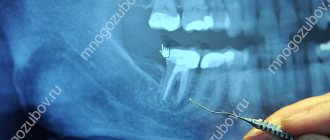The result of dental canal treatment is the preservation and restoration of a tooth that is infected or has other pathology. The main task here remains cleaning the root canal. Infection and dying tissue must be removed from it. The resulting cavity is then securely filled. If treatment is not started in time, the inflammatory process will spread further and the tooth will have to be removed.
What is a root canal
In addition to enamel and dentin, any tooth has a fairly large internal cavity. Its main part is called the pulp chamber. Thin tubules extend from it. They are located along the entire length of the roots. These are root canals. The number of roots varies among different groups of teeth. Accordingly, the number of channels is also different. The front teeth have only 1 canal. Side groups can have from 2 to 4.
Dental tubules are narrow tubes with many branches. They originate at the top of the root. This place is called the apical foramen. From here, neurovascular tissue passes to each root. If it is inflamed or dead, it is removed during endodontic treatment. Next, the resulting cavity is cleaned of its residues, disinfected and sealed.
Obliteration of root canals. Clinical case.
A patient contacted us. The orthopantomogram image clearly shows complete obliteration of the lumen of the root canal of the 21st tooth.
Fig. 1 Complete obliteration of the root canal of the 21st tooth on an orthopantomogram
Diagnosis was made using cone beam computed tomography (CBCT).
Rice. 2 Sagittal section of the area of the 21st tooth on a CBCT image
Taking into account the skeletal asymmetry of the lower jaw in the image, the main cause of obliteration of the root canal in this case can be assumed to be trauma.
Rice. 3 Axial section of the upper jaw area with obliteration of the root canal of tooth 21
When is endodontic therapy needed?
Strict indications are required for dental canal treatment. After all, if the neurovascular tissue is removed, the tooth loses strength and becomes susceptible to destruction. Therefore, endodontic treatment should be carried out only in cases of inflammatory processes or traumatic injuries. The most common are:
- Pulpitis. This is an inflammation of the neurovascular tissue (pulp). It is a soft, fibrous substance. In addition to blood vessels and nerve endings, it includes connective tissue and lymphatic vessels.
- Periodontitis. Inflammatory process in the root and adjacent tissues.
These diseases have the following symptoms:
- Swelling of the gums and changes in its color, the appearance of fistulas and purulent formations on it.
- Acute pain in the tooth that is aching or throbbing. It gets worse at night or with pressure.
- Putrid odor from the mouth.
Sometimes these symptoms may be absent. In such cases, inflammation is determined only upon examination. Only a specialist can make a conclusion about the need for endodontic treatment. He selects the most effective treatment regimen depending on the situation.
Causes of obliteration of tooth canals
The main and most common causes of tooth root obliteration are:
- injuries;
- chronic inflammatory processes;
- age-related changes;
- poor quality treatment;
- the presence of cancer associated with the proliferation of connective tissue.
There are also factors that increase the likelihood of root canal obliteration. These include:
- malocclusion;
- heredity (in particular with marble disease and Stanton-Capdepont syndrome);
- metabolic and endocrine system disorders;
- exposure to chemicals on teeth over a long period of time;
- decreased functionality or inactivity of the tooth during chewing.
Old methods of root canal treatment
Previously, endodontic treatment involved removing the pulp. For this purpose, for example, arsenic paste was used. It was inserted into the affected cavity and contributed to the death of the tissue. After this, the doctor removed the pulp from the tooth and filled it. This was the end of the treatment. Another common method was the placement of a resorcinol-formalin mixture. It froze in the cavity, thanks to which it was possible to stop the disintegration of tissues.
These methods had the following major disadvantages:
- Resorcinol-formalin and arsenic mixtures do not always completely kill the nerve. Therefore, when healing tissue, the patient could experience acute pain.
- Arsenic and resorcinol-formalin mixture are very toxic. They can accumulate in different organs.
- After pulp removal, tissue may remain in the root canals. Often they caused re-inflammation.
These methods of endodontic treatment were used due to the lack of adequate anesthesia, under which the affected pulp could be completely removed. Today dentistry has much more gentle methods.
Features of the treatment of chronic periodontitis with poorly accessible root canals
To localize the mouths of obliterated canals, it is advisable to use caries markers. produces the drug “CanalBlue” in disposable plastic pipettes with a thin tip of 0.125 ml. After adding a marker to the bottom of the tooth cavity, it is washed with water and dried with an air stream. Usually, the painted dots in the places of hidden canal mouths are well contrasted. It is also advisable to use means of optical magnification (microscopes, endodontic video cameras, binocular loupes, etc.).
In order to facilitate the passage and expansion of narrow and obliterated root canals, two methods are used: mechanical and chemical. Thin drills (reamers) are traditionally used to pass through channels; thin K-files are also used for this purpose. The angles of rotation of instruments in a difficult-to-pass channel should not exceed 45-90°.
(USA) offers a thin carbon endodontic instrument “Pathfinder” in two sizes for passing obliterated canals - “C-pilotfile” in six sizes (06, 08, 10, 12.5 and 15), Dentsply / Maillefer Corporation » - “ProFinder” (series of “Senseus” instruments) sizes No. 10, 13, 17 according to ISC, length 21 and 25 mm.
If the tooth root canal has poor patency, a chemical method can be used to expand it. For this purpose, complex or chelate substances are used, which decalcify dentin. The most commonly used is the sodium salt of ethylenediamine tetraacetic acid (EDTA). As a result of contact of EDTA with the wall of the tooth root canal, the latter is decalcified and softened, which significantly facilitates the process of mechanical expansion of the tooth root canal.
The best decalcifying effect was observed when using 20% tri-sodium salt EDTA (Berezovskaya V.I., 1966). After drying the tooth root canal, the EDTA solution is injected into the passable part on cotton pads or using a syringe and injected with a root needle. After 30 seconds, the spent EDTA solution is removed with a cotton swab, this procedure is repeated for 5-8 minutes, after which they try to mechanically remove decalcified dentin from the tooth root canal. Considering that EDTA does not have a negative effect on the oral mucosa and periapical tissues, its solution can be left for 12-24 hours in the tooth root canal. The success of using EDTA depends on the freshness of the prepared solution and the length of time it remains in the tooth root canal.
EDTA in the form of a solution is contained in the preparations "Largalultra" (Septodont), Edetat (Pierre Rolland, France), Endofree (Dencare), RootCanalEnlarger (Dentaires), Chela-JenLiquid (“Alpha-BetaMedicalSupplyInc.”), “Kanal-Dent-E” (“VladMiVa”), SmearClear (“SybronEndo”), etc. It should be noted that the importance of these drugs is currently increasing; their use is recommended not only in difficult-to-pass canals, but also for medicinal treatment of well-passable canals in order to influence the smear layer of dentin on the walls of the canals of the roots of the teeth, alternating with irrigation with a 3-5% sodium hypochlorite solution (Gettleman V.H. etal., 1991; Chistyakova G.G. , Manak T.N., 2006, etc.).
The use of EDTA in gel form is recommended during mechanical treatment of tooth root canals; it significantly reduces the likelihood of endodontic instrument breakage and facilitates the passage of canals and giving them the shape necessary for filling. Representatives of this group of drugs are “Canal +” “Septodont”, “RC-prep”, “RC-lube” (PremierDentalProd), “HPU 15” (“Spad”), “Endo-gl” (“VladMiVa” ), “FileCareEDTA” (“VDW”), “Glyde” (“Dentsply”), etc. These drugs cannot be left in the root canal under a bandage.
To chemically expand the root canals of teeth, you can successfully use a 36% solution of metacresol sulfonic acid, i.e. vagotil, which has a decalcifying effect and at the same time is a broad-spectrum drug (Gunchenko L.S., I Bogatyreva V.A., 1990). Due to its viscous consistency, vagotil diffuses well into the narrow canals of the tooth root, exhibiting a decalcifying effect not only in breadth, but also in depth. In teeth on the lower jaw, it is convenient to apply the drug using the jaws of tweezers or a pipette at the mouth of the canal, and then use a root needle or thin drill to pump the liquid into the canal. Residues are removed with a cotton ball. In teeth on the upper jaw, it is better to introduce vagotil into the root canals of the tooth with a drill, on which a thin cotton wool is wound to hold the solution. Vagotil can be left in the root canal of the tooth on the turunda for 24-48 hours under an airtight bandage. In our opinion, it is advisable to study the possibility of using vagotil to remove the mineral component of the smear layer of the walls of the root canals of teeth. It should be taken into account that for the treatment of obliterated canals and effects on the smear layer in endodontics, it is possible to use citric and phosphoric acids (but not liquid phosphate cement!) in a concentration of 6% to 30% in combination with a solution of sodium hypochlorite, however, the use of EDTA has an effect on dentin has a more gentle effect. After applying the acid solution, it is recommended to rinse the canal with distilled water, since there is a tendency for crystallization and precipitate to form on the canal walls.
A special situation arises when it is necessary to unfill previously filled root canals. In this case, special preparations are used to distinguish between filling materials in the canals. Thus, to soften materials based on eugenol and zinc oxide, Endosolv E (Septodont), DPS 10 (Spad), Eugenat (Omega-Dent), etc. are used.
“EndosolvR” (“Septodont”), “Resosolv” (“Pierre Rolland”), “Fenoplast” (“Omega-Dent”), etc. are intended for softening materials based on a resorcinol-formalin mixture.
It is believed that the liquid and gel "Solvadent" ("VladMiVa") promote disobturation of canals after filling with both zinc oxide-eugenol materials and phenol-formaldehyde resins, glass ionomer and zinc phosphate cements.
According to our observations, in the treatment of periodontitis, the gel “CarisoM” (“MediTeam”) can be successfully used as a means for chemical expansion of the root canals of teeth. Used to lubricate files during canal machining.
Modern methods of endodontic treatment
In the treatment of tooth canals today there are two approaches: therapeutic and surgical. Let's look at them in more detail:
Therapeutic treatment. With this method, it is possible to preserve the entire pulp or at least part. The drug is placed into the cavity. The pulp chamber is isolated using a special gasket, then the tooth is filled. The drug can also reach tissues through dentin. To do this, special bandages with antibiotics are applied to the tooth. This therapy is used only in the initial stages of the inflammatory process.
Surgery. In this case, the pulp is completely removed, the canals are cleaned, disinfected and sealed. There are the following methods for filling cavities:
- Classical. The canals are filled with conventional filling material.
- Vertical filling. A special filling composition is administered as an injection.
- The use of thermophiles. A special heated composition on a carrier is placed into the cavity.
Sometimes, in order to cure the canal, you have to remove the tip of the root. This measure is necessary for cysts, granulomas, perforations, fibroids and other problems.
Modern method of treating tooth canals: treatment of the canal cavity under a microscope
The quality of dental canal treatment depends on the correctness and accuracy of cleaning and processing of their internal space. This is a very painstaking work, since the channels themselves are quite narrow (no more than one millimeter), and in addition, they can have bends and turns. If a specialist makes a mistake when treating the canals and does not remove particles of the affected dentin, a relapse of the inflammatory process is guaranteed. The use of a special tool in treatment - a dental microscope - will help eliminate possible errors and inaccuracies in the treatment of dental canals.
Using a microscope, the dentist will perform a high-quality removal of all infected tissues, while preventing injury to healthy tooth tissues. The use of the device simplifies the process of cleaning and processing channels with significant lengths, anomalous structure,
with curvatures and branches. In addition, the use of a dental microscope during the treatment of tooth canals improves the quality of tooth restoration as a whole, and also contributes to the timely detection of hidden caries.
At our dental clinic “Uni Dent” in St. Petersburg, you can receive services for dental canal treatment under a microscope. The procedure is carried out by highly qualified doctors using modern instruments and materials, and therefore when you contact us, you can rest assured that the treatment result will be of high quality! Dentistry "Uni Dent" - come to us for a beautiful smile and painless dental treatment!
Stages of endodontic treatment
- Diagnostics. If there is a suspicion of problems in the dental canal, an x-ray is taken. The specialist can also study the images that the patient already has. Depending on the diagnostic indications, treatment is selected.
- Pulp removal. First, the dentist anesthetizes the tooth. Then he opens it and removes all damaged tissue. Next, the cavity is given a convenient shape. Then the channels are disinfected using a special solution.
- Root canal filling. The cavities are filled with special materials. They are divided into hard (pins), hardening (various cements) and plastic (paste or gutta-percha). The most modern are the latter.
- Tooth restoration. This is the restoration of the shape of a tooth using a filling, crown or inlay.
Treatment of instrumentally inaccessible (impassable) canals
The patency of the root canal depends mainly on the degree of its curvature and the location of the curvature:
— up to 25° — the channel is instrumentally accessible;
— from 25 to 50° — the canal is difficult to access instrumentally;
— from 50° — the channel is unavailable.
The location of the curvature closer to the mouth part makes it possible to expand the mouth part and facilitate the passage of the root canal even with significant curvature. There are other possible causes of canal obstruction. In the presence of hard-to-reach and inaccessible canals, devital amputation followed by mummification of the root pulp is indicated in the treatment of pulpitis. For this purpose, it is possible to impregnate (soak) the root canals with a liquid filling material containing resorcinol and formalin. For example, forphenan, foredent, etc. In addition to resorcinol and formalin, the liquids contain a catalyst for the polymerization reaction. Under the influence of a catalyst, the liquid turns into a glassy mass. Impregnating compounds have the ability to penetrate microtubules of hard dental tissues, providing a disinfecting and blocking effect. They can stain the tooth.
For impregnation, solutions and pastes containing parachlorophenol (cresodent, cresophen, cresopath, etc.) are used. Their antimicrobial effect is associated with the denaturation of microbial proteins in the canal. The material hardens by binding to the intracanal fluid.
Impregnation of instrumentally inaccessible channels can also be carried out using the silvering method, using an aqueous (30%) or alcoholic (3%) solution of silver nitrate. A 4% hydroquinone solution is used as a silver reducing agent. Sterilization of root canals by this method is based on the property of silver nitrate to diffuse deeply into the dentinal tubules, have a pronounced bactericidal effect, and obstruct the dentinal tubules by forming a film (silver mirror reaction). Treatment is also carried out in three visits. Silver ions can also be introduced into the channels using electrophoresis. The method is popular in children's practice.
Currently, as an alternative, a method of treating hard-to-reach canals has been proposed - depophoresis.
copper-calcium hydroxide, which is also carried out in two or three visits. When using this method, tissues are saturated (creating a depot) with ions of calcium hydroxide, copper hydroxide, and hydroxyl group. Filling the traversed part of the root canal is carried out with atacymite. A prerequisite is the passage of the canal by 1/3 - 2/3, preventing the entry of copper-calcium hydroxide into the periapical tissue. According to Professor Knappvost, under the influence of an electric field, copper-calcium hydroxide, penetrating into the canal system, ensures sterilization of the canals and root dentin and obturation of the holes.
5. Homework:
1. Write out the classification of means for irrigation and disinfection of root canals.
6. Literature:
Petrikas A.Zh. Pulpectomy. A textbook for dentists and students. — 2nd ed. - M.: AlfaPress, 2006. - 300 p.
2. Cohen S., Burns R. Endodontics: Trans. from English - St. Petersburg, 2000.
3. Poltavsky V.P. Intracanal medicine: Modern methods. - M.: Medical Information Agency LLC, 2007. - 88 p.
7. LEARNING OBJECTIVES:
1. Patient Z. came to the clinic with complaints about the presence of a carious cavity in the tooth, food retention between the teeth.
Objectively: on the chewing surface of tooth 37 there is a deep carious cavity filled with softened dentin and food debris. Temperature tests are weakly positive, probing the bottom of the carious cavity is slightly painful. Electroodontodiagnosis of the tooth (EDD) was carried out; the obtained values were 40 mA.
Make a diagnosis. Make a treatment plan.
Canal treatment using a microscope
The diameter of the root canal of a tooth is approximately 1 millimeter. In such conditions it is impossible to work with it without special optics. The dental microscope allows you to increase visibility up to 32 times. Therefore, it is increasingly used in modern dentistry.
Advantages of using a dental microscope:
- The specialist can see and remove only tissues affected by inflammation, without touching healthy ones.
- An excellent overview of the tubule orifices is achieved. Seeing the number of their branches, depth and directions is very important during endodontic treatment.
- Due to targeted treatment of the pulp, complications can be avoided. The possibility of perforations is also eliminated.
Dealing with complex root canal anatomy
Author: Bobby Patel
Translation: Zvorykin Sergey
Curved root canals
Most teeth have varying curvatures in different areas of the root canal system. Canal preparation in curved roots poses a challenge due to the increased risk of canal transport due to the straightening property of the instrument. This may manifest itself as an increase in the amount of dentin removed on both the outer radius of the apical curvature and the inner radius of the coronal curvature. Another major concern when working in curved roots is the risk of instrument fracture inside the root canal during preparation. In clinical practice, instrument fracture occurs as a result of either torsional failure or bending fatigue. A torsion fracture occurs when part of the tool jams while the other half of the file continues to rotate. Bending fatigue occurs when the tool rotates freely around a curve, undergoing cycles of tension and compression until the file inadvertently breaks.
As previously presented, there is a complex relationship between the degree of canal curvature, its radius, and its length, which can contribute to instrument failure and canal transport. The following conclusions can be drawn: that a large angle of curvature, a small radius and a large extent of curvature lead to an increase in the load on the endodontic instruments used for preparation. Clinical methods for assessing canal curvature are limited to single bends measured on a two-dimensional radiograph in the mediodistal plane. If multiple curvatures are present or the curvature is in the buccolingual plane, then an accurate assessment cannot be made.
Stainless steel instruments can be used for manual preparation of curved root canals, but a balanced force technique must be used to minimize the risk of canal transport. Larger files are inherently stiffer, resulting in a reduced ability to follow the curve of the canal (files larger than 20 ISO). Pre-bending the tip of the stainless steel file is mandatory, although in highly curved canals the risks of transport and perforation are still very high.
There are now many techniques available for root canal preparation using nickel-titanium rotary instruments with increased efficiency and speed, and reduced risks of canal transport when used properly. Assessing canal curvature, properly created access, widening canal orifices using a crown-down approach, creating a reproducible glide path, following manufacturer's recommended speed and torque settings, irrigation, proper instrumentation, and operator skill through hands-on education and training on extracted teeth should be the right direction to minimize the number of iatrogenic errors.
Root canals with low curvature (<5°)
Clinical case No. 1. A 48-year-old male patient was referred to the clinic with localized pain in tooth 1.6. Clinically, tooth 1.6 was sensitive to percussion. Preoperative radiographs revealed the presence of a huge restoration involving the pulp chamber. A focus of radiolucency is noted on the palatal root (Fig. 1).
Figure 1. Radiographs demonstrating conservative root canal treatment of tooth 1.6 with crooked canals.
Recommendations after endodontic treatment
After stopping the inflammation of the pulp, it is necessary to consolidate the result. To do this, the patient must adhere to the following simple rules:
- Do not eat spicy, cold or hot food for several days. You need to wait until the treated teeth lose sensitivity.
- Maintain oral hygiene. You need to brush your teeth and floss twice a day.
- Eliminate solid foods from your diet for a while. Failure to comply with this rule can lead to tooth decay.
- Go to the dentist for dental checkups 2 times a year.
After endodontic treatment, teeth will become especially sensitive. This is how the body reacts to the filling material. However, after a few days this effect will disappear.
What is a dental microscope and why is it needed when treating root canals?
A dental microscope is considered today one of the prerequisites for the work of a modern dentist. Meticulous and highly precise endodontic treatment is impossible without magnification. Using a microscope helps:
- Clean the canal in the most inaccessible places, without missing anything, using the finest tools
- Preserve the maximum amount of healthy tissue
- Find missed root canals
- Guaranteed to remove all dental tissue affected by caries
- See cracks in the tooth
- Carry out the procedure quickly and accurately, remove the remains of old restorations or a broken instrument in the canal (during retreatment)
- Eliminate the risk of complications
The doctors at our clinic have the best equipment to achieve ideal quality. Of course, endodontic treatment in our clinics is carried out only under a microscope.
Important: endodontic treatment is an indication for crown installation. Of course, after canal treatment, the doctor will restore the tooth with composite material, but such a tooth still needs to be strengthened with a crown. Therefore, after root canal treatment, contact our orthopedic dentists!
Cost of services
Treatment of dental canals Price
Treatment of dental canals from 3000 rub.
1-canal tooth (mechanical and medicinal treatment of the canal) 900 rub.
1-canal tooth (canal filling with gutta-percha pins) 750 rub.
2-canal tooth (mechanical and medicinal treatment of canals) RUB 1,500.
2-canal tooth (canal filling with gutta-percha pins) 980 rub.
3-canal tooth (mechanical and medicinal treatment of canals) RUB 2,100.
3-channel tooth (canal filling with gutta-percha pins) RUB 1,300.
Expert of the article you are reading:
Akhmedkhanov Said Rashidovich
Dental surgeon, general dentist, implantologist, orthopedic dentist, dental therapist.
You may also be interested in:
Dental treatment during pregnancy Dental consultation Treatment of dental cysts Increased sensitivity of teeth: causes and methods of treatment Filling of dental canals Treatment of pulpitis Treatment of fistula on the gums Treatment of flux (periostitis)
Show more
Treatment regimen
The procedure includes:
- taking a photo. The image allows the doctor to better plan treatment, know the number and location of the channels. In our clinics, 3D images are taken for complex roots
- anesthesia
- removal of dental tissue affected by caries
- nerve removal or root canal filling
- determining the length of the root canal using an electronic apex locator
- widening the passage using machining
- medicinal treatment of the root canal with antiseptics
- filling according to the chosen method
- control x-ray
At the end of the procedure, the doctor recommends that the patient not eat hot food for 1–2 hours.









